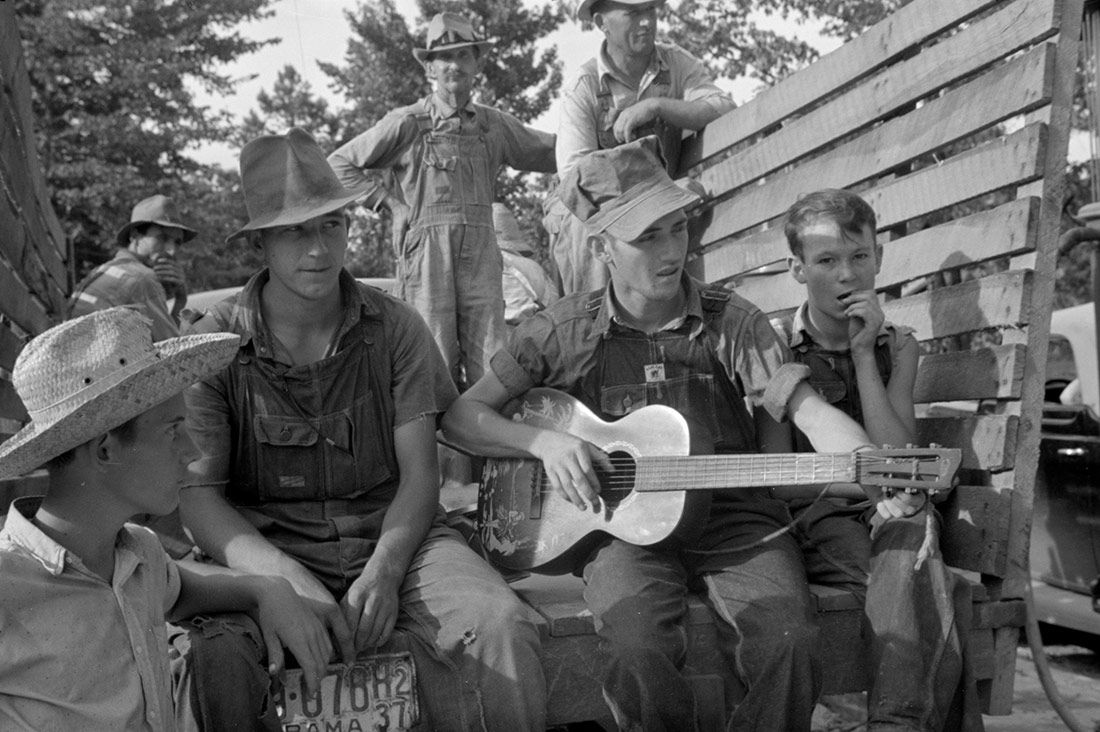
Young musicians at Skyline Farms, Alabama, 1937 | Ben Shahn, Library of Congress | Public Domain
Trap is much more than controversial lyrics and voices combined with auto-tune. The boom of this genre has a lot to do with the democratisation of access to new technologies, whether creating or disseminating musical creations. Max Besora, co-author of Trapologia (2018), offers a review of the history of this style of music that has seduced half of the world’s young people.
If you’ve never heard of trap, you’ve probably heard it without realising on the phone of someone sat next to you on the underground or in the piped music of a store or shopping centre while you were buying stuff you never knew you needed in the sales. Trap music is a rap subgenre that appeared in the early 1990s in the poorest neighbourhoods of Atlanta (USA), the home of trap houses, which are houses where crack and other drugs are produced and sold, and where consumers find themselves “trapped”, talking their own underworld and their own slang, outside the margins of the system.
The word “trap” started to emerge in the late 1990s, via the Dungeon Family collective. But to understand the birth of trap music, we have to go back to the origins of hip hop and the parties of the Bronx, in 1970s New York, with DJs and MCs such as Afrika Bambaataa, Kool Herc and Grandmaster Flash, and others who rapped over mixed beats. As it came out of the ghetto and into the commercial mainstream, in the 1980s, groups emerged such as Public Enemy, Rakim, KRS-One and Native Tongues, known as the New School, rapping a street poetic of social demands.
Later, in the 1990s, musicians such as N.W.A., UGK, Three 6 Mafia, Master P, Dr. Dre and Ice-T, among others started what has been termed gangsta rap, talking about the violent lifestyle of the disadvantaged neighbourhoods of American cities, and leaving aside the more political and poetic discourses of the earliest rap. This transformation of the genre spread to Mystic Stylez (1995) by Three 6 Mafia to reach Gucci Mane and his Trap House (2005).
And the fact is that while gangsta rap was a mutation of the original hip hop, trap would be a second mutation derived from gangsta, converting it into a new culture, different from that of the original hip hop, often forgetting the verses, committed ideology/poetics and rhyming, and with certainly more sinister musical tones. Without musicians such as Future, Migos, Gucci Mane, Fetty Wap, and 2 Chainz, and producers such as Shawty Redd, Mannie Fresh, Zaytoven and Tony Fadd, trap would not exist as we know it today, having achieved unprecedented success among the younger generations, in both audience and production terms.
Trap music, with its three-note synths, false gold teeth and overdose of ironic Auto-Tune, spread from Atlanta and the rest of the southern USA, passing through Latin America and spreading around Europe and Asia. If the peak point of this music genre in the United States occurred in around 2010, it arrived in Spain in around 2013, above all with the Kefta Boyz, who would later change their name to PXXR GVNG, with Khaled and Yung Beef at the head. Musicians would later emerge such as D. Gómez, M. Ramírez, C. Tangana and Big Jay, Pimp Flaco, Kinder Malo and Cecilio G or P.A.W.N. Gang, not to forget La Zowie and Ms Nina, while others such as Bad Gyal, Nathy Peluso or even Rosalía mixed beats originating from trap with other music genres with much more exciting results. Furthermore, all these musicians have the merit of singing or rapping in a mixed, anti-regulatory language, inventing surprising linguistic registers.
However, not only is irreverence for linguistic norms a fundamental part of this type of music, but so, too, is its aesthetic of sought-out ugliness, originating from the underworlds of drug trafficking in the United States, which finds its correlation here in Spain with what was called quinqui cinema in the 1980s, passing from “camp”, intentionally ugly and precarious, to the most commercial “kitsch”, as well as the re-reading of the gender roles that articulated many of its female voices, with questions about sexism, the objectification of the female body, abortion, racism, classism or misogyny from Las VVitch, Tribade, IRA or Chocolate Remix.
Unlike hip hop, the global success of trap music has, among others, two possible explanations: firstly, it is very much related with the development and accessibility of technology and the social networks. It could be affirmed that trap is the first musical style where people without a discography or money to pay for a demo could make music from their computers. Posting these songs/videos onto digital platforms has become a revolution with the way of making, thinking and communicating music. Meanwhile, its global success is directly related with the fact that many of the words of this type of music are generally aimed at social classes disadvantaged by the economic crisis and unemployment, independently of their place of origin. Thus, young people from all over the world, foreseeing a black future for themselves in the face of an unequal social system, feel this music like a prophecy that illustrates the path for them to follow.
Paradoxically, despite trap openly embracing capitalism with its lyrics about success, fame, luxury, money, etc., its neoliberal pragmatism with its all-American and do-it-yourself basis enabled it to escape the monopoly of the big record companies that were controlling the music market. It was a way of saying “we don’t accept the rules of the game anymore, now we’re going to play it our way”. This meant questioning the functioning of the industry while, at the same time, making use of it. Trap music brings an end to the exclusivity of the record/object, previously considered as an exclusive piece of art and participates in the power of the global community, where the meta-tale or legitimising discourse on an ideological, social and political level, has been replaced by a plurality of small, fragmented narratives spread around every corner of the cybernetic world. There has been a gain in terms of musical democracy, but a loss in terms of the social message and the transforming power that hip hop could have in exchange for perpetuating individualism, consumerism and the artificiality of neoliberal values.
The debate remains open and, in recent times, a series of studies have appeared in Spain that analyse, from diverse viewpoints, the blazing success of this musical phenomenon. Historia del trap (2018), by Jon I. García, empirically traces the beginnings of the genre in the United States and its subsequent disembarkation in Latin America and Spain. Trapologia (2018), written by Borja Bagunyà and Max Besora, is an essay/fiction that narrates the adventures of two writers aged nearly forty who venture into this underworld to research, understand and reflect, with humour and in a cross-disciplinary way, on this musical genre that escaped their generation. El trap: filosofía millennial para la crisis en España (2019), by philosopher and cultural agitator Ernesto Castro, is a philosophical and sociological essay on this musical genre in Spain and its most representative figures, reflecting at the same time on feminism, cultural appropriationism and the class struggle.
Whatever the case, just like hip hop and other popular music genres such as rock, punk, or reggae, trap is not merely a musical genre but a way of living, of dressing, of talking and of self-expressing for an entire generation of young people meeting up at places to dance or rap, the semiotics of an expression that is diffused via a rhetoric that ranges from social media networks to street graffiti, with its own systems of functioning, codes and specific laws. This has happened before: teddy boys, mods, skinheads, punks, b-boys, every musical scene that has existed, provides its members with a feeling of identity to latch on to and also a challenge of the conventional norms with a specific attitude. You may like trap more or less, but trap, like any other musical genre, is like the planet Earth: the diamonds are always hidden under the surface.



Leave a comment